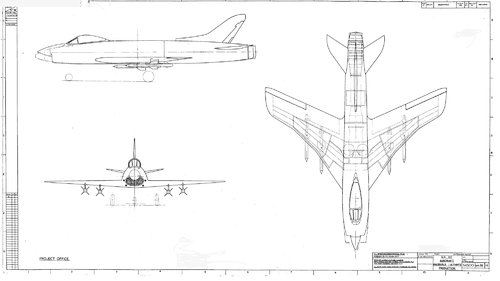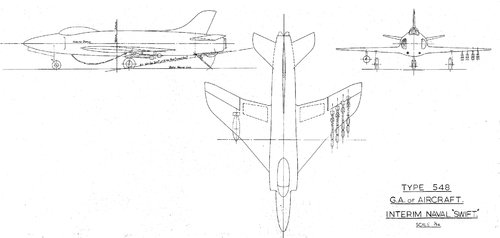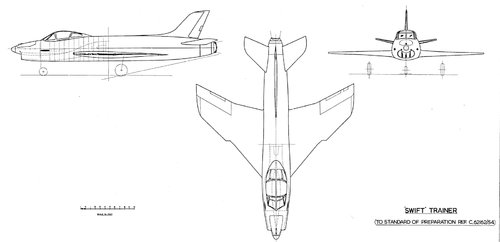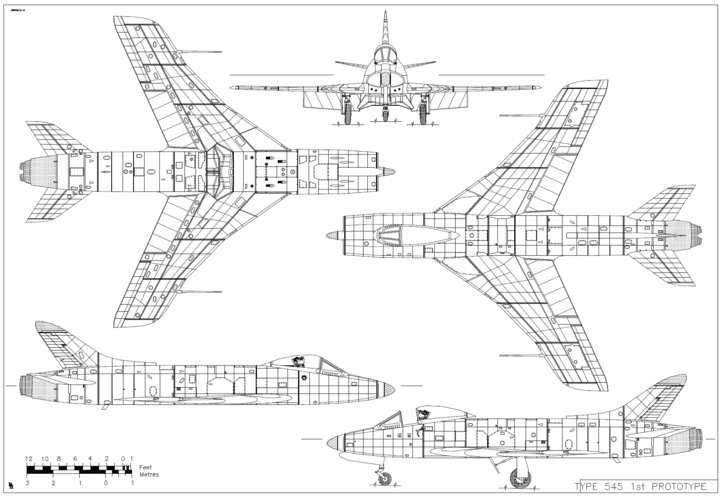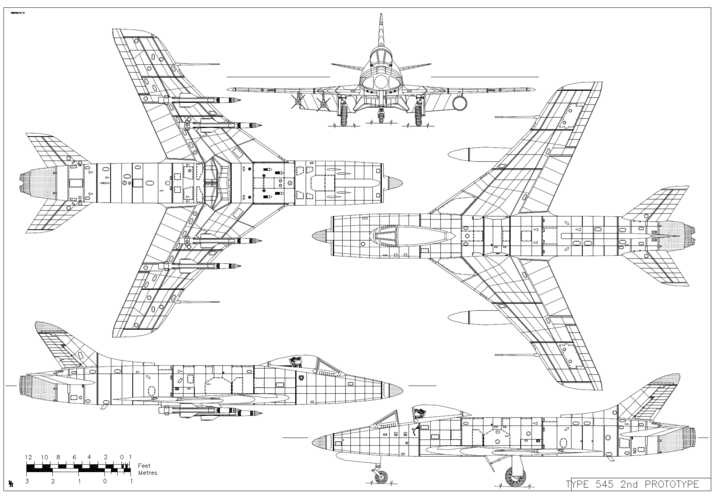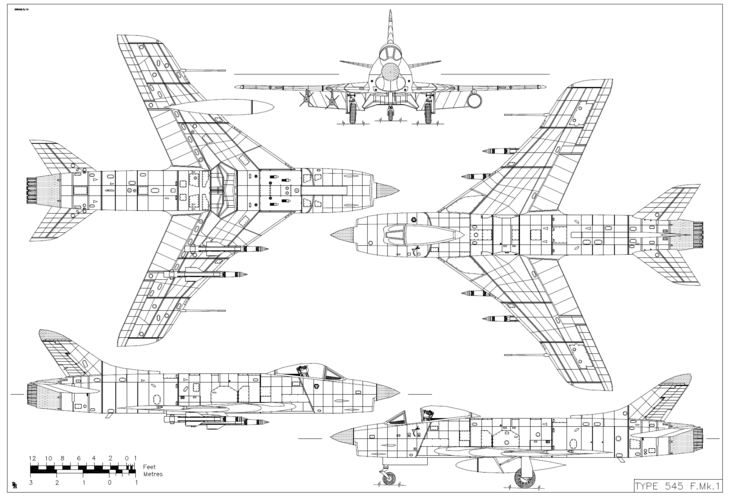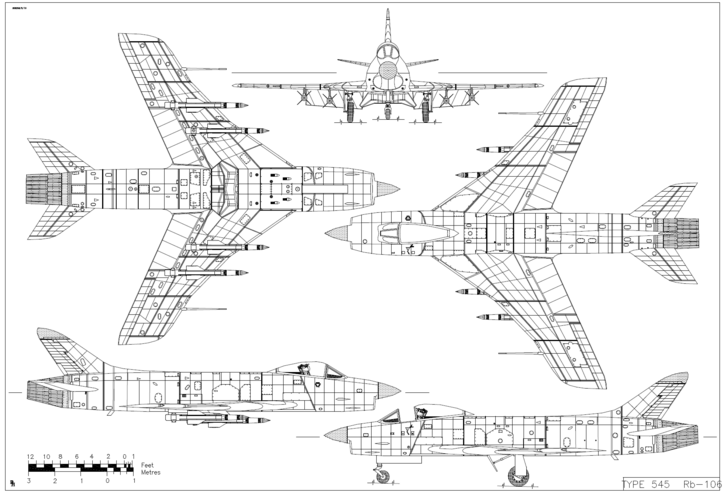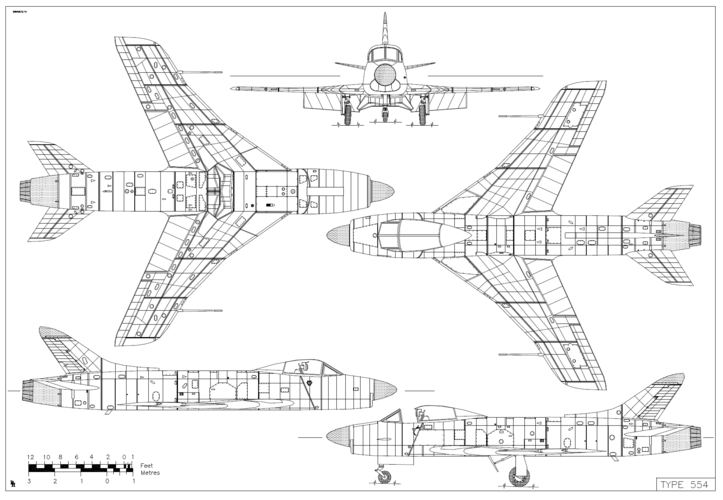Info on the Production & Trainer 545 from unpublished Barrie Hygate Swift monograph.
PRODUCTION VERSION.
The ultimate proposed production interceptor used the same wing, fin and tailplane, with a slightly fatter rear fuselage to cater for the larger diameter afterburner jetpipe, but the forward fuselage was radically altered. The nose was shortened by 9" (compared to the first prototype) and a conical, pointed and more circular cross-sectioned nosecone added to house an 18" diameter radar scanner. The nosecone was faired into the intake upper lip, which was also moved aft, the resulting profile being very similar in appearance to that of the F-86D Sabre. The "chin" intake thus formed was bifurcated internally forming the nosewheel bay and passing either side of the cockpit as before. The fuselage nose topline was raised, so that although the cockpit canopy topline itself was virtually unaltered, the sill did not slope down at such a sharp angle, this also making the fixed windscreen and quarter-lights shallower. The nosewheel oleo now retracted aft, its bay being directly under the cockpit floor. The resulting wheelbase, however, remained the same as before.
Aft of Frame 8, the forward fuselage was unaltered back to the transport joint. As mentioned above the aft fuselage was slightly fatter to accommodate the larger diameter afterburner section. It also terminated at Frame 30, there being no tailcone attached. When fitted with the RB 106 engine, there was to be an additional fuel tank fitted around the jetpipe. From the rear of the fuselage structure jutted the long convergent/divergent, fully variable afterburner nozzle. Its throat diameter was 34.4", in the dry thrust (closed) position, nozzle diameter was 25.7", and when fully open, 43.0".
The same external armament of four Firestreak missiles was to be carried underwing, as on the second prototype, but the internal weapon layout was drastically revised. The inner pair of cannon were identically placed to the earlier prototypes, but the outer pair were moved up the fuselage sides either side of the intake ducts, to a position level with the bottom line of the radome. The ammunition boxes were still housed in the forward wing roots.
TRAINER VERSION.
One further version of the basic design was proposed, a two-seater advanced trainer to meet the requirements of O.R.318, and designated Type 554. This had basically the same external layout as the single-seat production interceptor, but with a more rounded nosecone, the main external difference being the side-by-side two-seater cockpit and canopy. Existing drawings of the aircraft do not make it clear whether the canopy slid aft for entry and exit, or whether it was of the "clamshell" variety, as on the Hunter T.7. Each pilot sat on a Folland/Saab lightweight ejection seat. An operational capability was retained, together with the radome housing the same 18" diameter radar scanner, which presumably meant that the missile armament could be carried, no records remaining to confirm this. The nosewheel oleo retracted aft to lie under the cockpit floor, between the internally bifurcated intake, the ducts of which lay entirely under the wider cockpit. All internal armament was deleted except for a single Aden cannon mounted on the left side of the fuselage nose, with 200 rounds (giving 10 seconds fire) being housed in the left wing root leading edge. Wing fuel capacity was slightly reduced, each holding only 150 gallons, the aft fuselage tank was also reduced to 110 gallons capacity, but the forward tank was increased holding 175 gallons. The power plant was to be a Rolls Royce R.A.19R Avon with a 2,000øK afterburner with fully variable nozzle.
REFERENCES
Prototype Notes Type 545 (XA 181) - Technical Manual.
Public Records Office - Avia 54.
R.A.F.Museum - Supermarine Archives.
Eric Morgan - Supermarine Archives.
Dowty Archives - Drawings E.59427 / E.5961Y.
Rolls Royce Archives - Drawings BTS 8050 / 8082.

